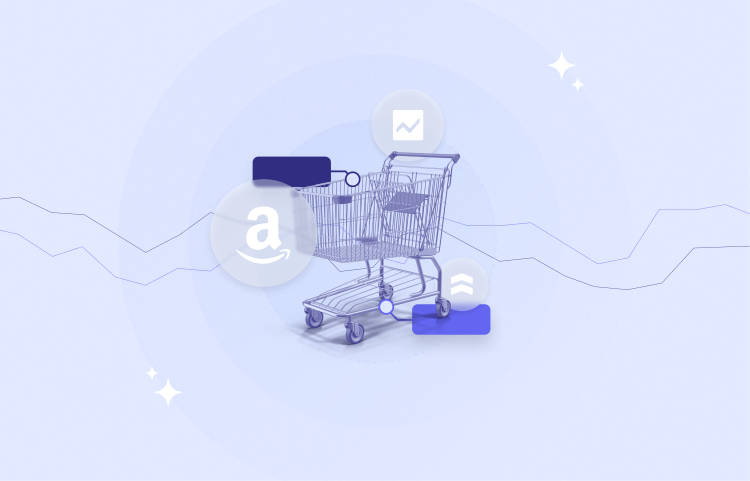
Amazon Prime Early Access Sale – Our Recommended Strategy for Maximum Success
Stephen Bench-Capon, October 5, 2022
Amazon left it until the last week of September to announce their Prime Early Access Sale, which is scheduled for October 11th and 12th 2022. This gave advertisers just over two weeks' notice to develop a strategy and prepare campaigns for this shopping event that bears many characteristics of an Amazon Prime Day, even if it has officially been given a different moniker.
In this article, we analyze data from the last two summer Prime Days from this year and last year, as well as 2020, which was the last time Amazon's premier shopping event took place in the fall.
The aim of our analysis is to understand how selling dynamics and consumer behavior are impacted by Prime Day (or a Prime-exclusive shopping event). We look at ad sales, ad spend, CPC, ACOS and conversion rate data and use this to show which strategies have proven successful for advertisers in the past, and which are recommended to help you maximize your profits this fall.
Read on (or click the links) for answers to the following questions:
Should we expect a repeat of fall 2020's Prime Day this time around?
Can we directly connect increasing ad spend to increasing ad sales?
What do conversion rates tell us about consumer behavior on Prime Day?
Which strategy is recommended for this year's Prime Early Access Sale?
What is the Prime Early Access Sale?
Amazon's Prime Early Access Sale, scheduled for October 11th and 12th 2022 is a deal-heavy Amazon shopping event that has much in common with an Amazon Prime Day, such as:
scheduled as a two-day (48-hour) event
takes place across 15 countries.
reserves special offers exclusively for Amazon Prime subscribers
includes Lightning Deals familiar to Prime Day advertisers.
The name "Prime Early Access Sale" is in reference to upcoming holiday-season events, most notably Black Friday and Cyber Monday. The message is that Prime subscribers can already benefit from special offers over a month before Thanksgiving (this year on 24th of November).
Prime Day data analysis
Before we get into our analysis, here are a few notes on the data used:
All data used is anonymized Amazon advertising data
All data comes from active Sponsored Products campaigns
The marketplace analyzed was Amazon.com (US)
Where baselines for percentage changes are used, these are calculated using the median of advertiser performance across the 30 days prior to Prime Day.
Perpetua manages and maintains one of the most extensive Amazon advertising databases in the world. Nevertheless, the data presented here, while indicative of advertising trends, does not represent any official data from Amazon Advertising, nor is it necessarily reflective of the experience of every advertiser.
How much do ad sales really go up on Amazon Prime Day?
It is widely understood that sales—with our focus here on ad sales— go up on Amazon Prime Day. We've taken a look at the data to see how ad sales grew during the last two iterations of Prime Day, which took place in July 2022 and June 2021.
For this chart, as with all subsequent charts in this article, we've calculated a baseline based on the 30 days prior to Amazon Prime Day, and then shown how each day's rate deviates from this. For example, +50% indicates that ad sales on that day were 50% more than the baseline. The Prime Days in both years (dashed vertical lines on the chart) took place on different dates, but they have been aligned on the x axis to allow for easier comparison.
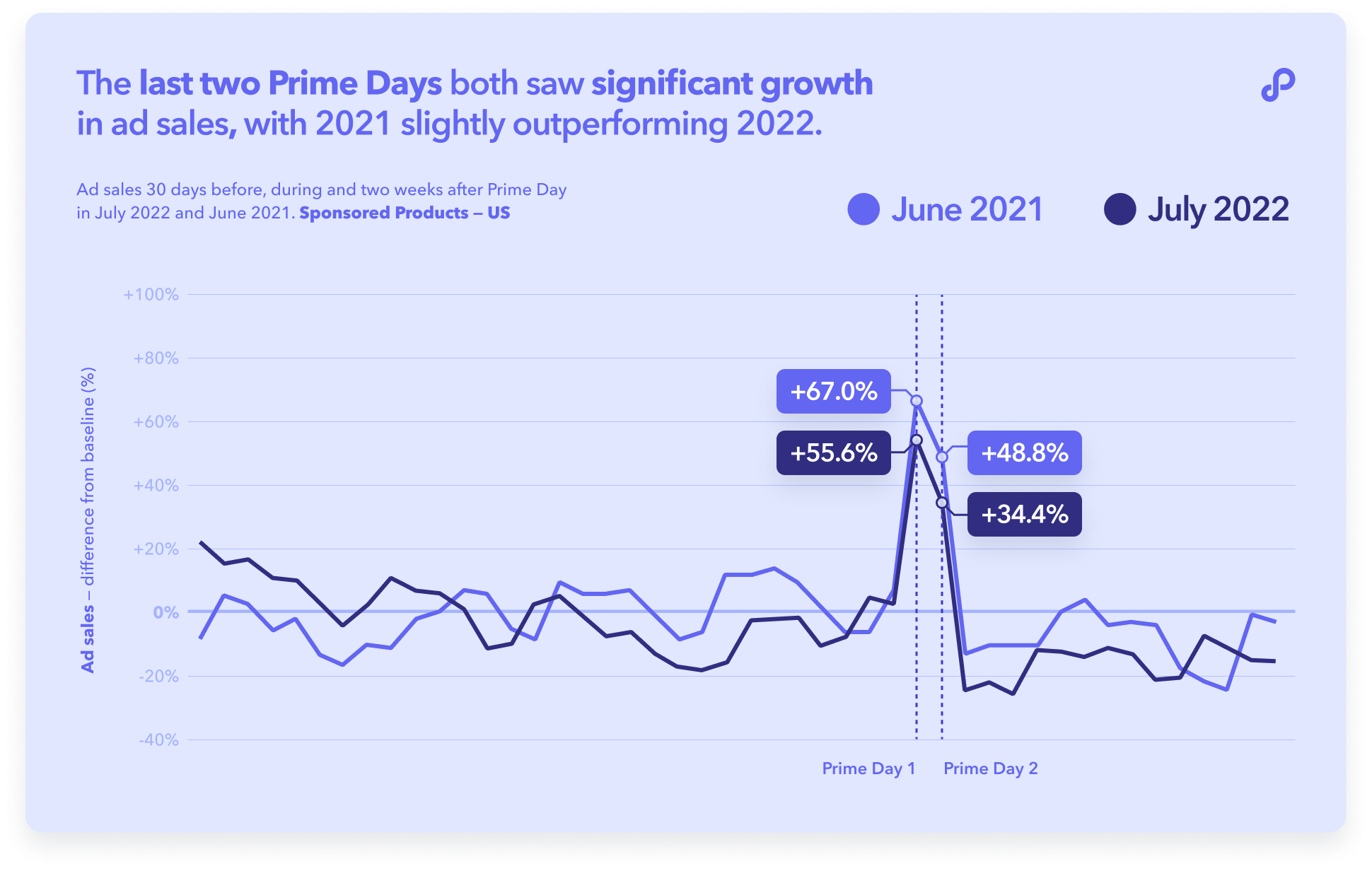
The chart confirms expectations of increased ad sales during Prime Day. In particular, we observe the following:
Ad sales rose more during Prime Day 2021 than during Prime Day 2022
In both 2021 and 2022, more ad sales were generated on the 1st day of the shopping event, with a slight decline on the 2nd day
In both years, there was a considerable drop immediately after Prime Day, with ad sales falling to between 10-20% less than the baseline
There was no significant upward or downward trend in the run-up to Prime Day in either year.
The last two Prime Days both took place in summer. For context, we can also look at the last fall Prime Day, from 2020.
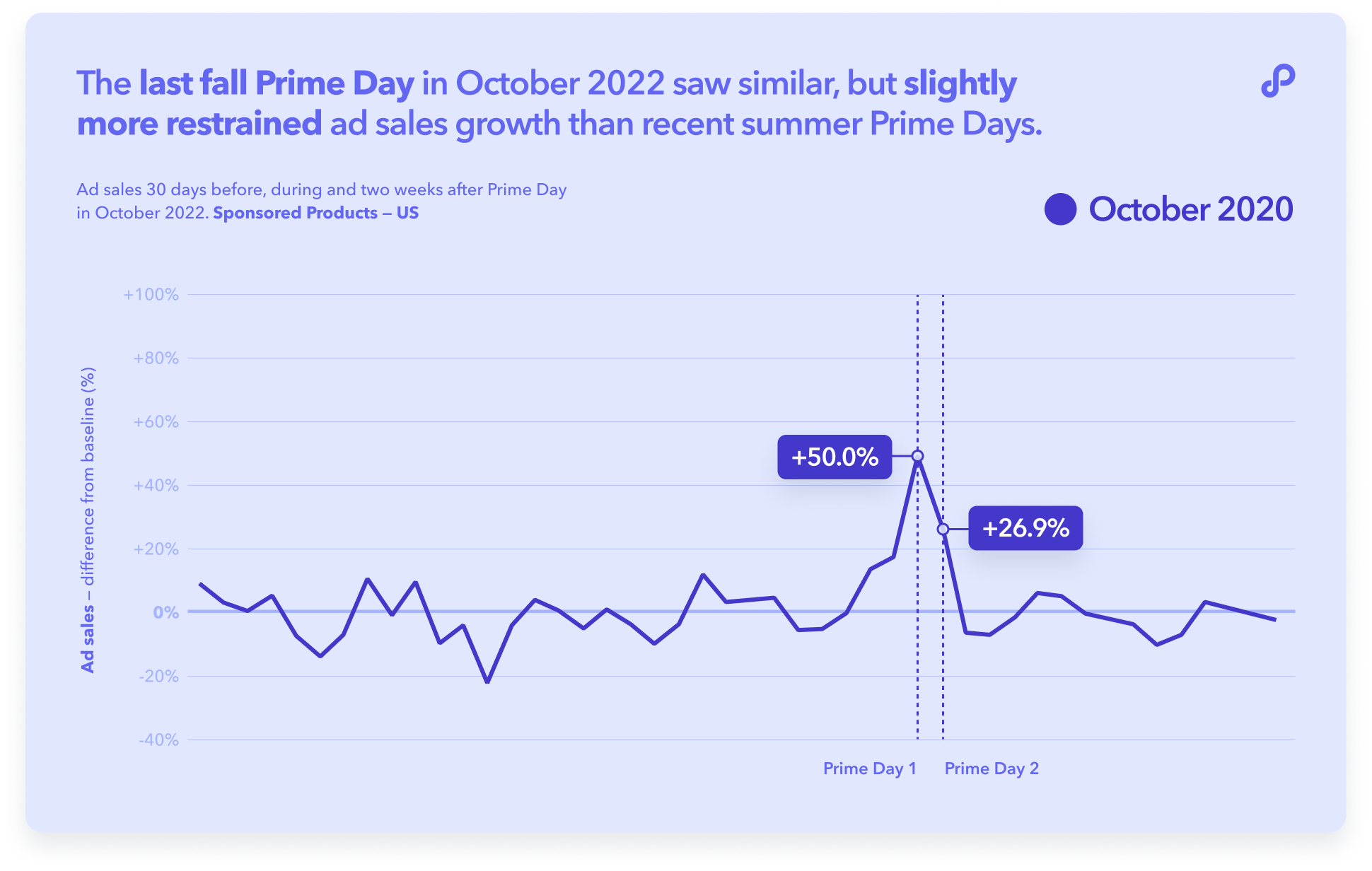
October 2020's Prime Day also saw growth in ad sales, but not of the same magnitude as either 2021 or 2022. Other trends are also observed in common with summer Prime Days, such as more sales on day 1 than day 2.
Should we expect a repeat of fall 2020 in 2022?
Seasonality plays a huge role in eCommerce, with Q4 and the holiday season being the make-or-break period for many, as a significant proportion of yearly revenue is (hopefully) made. Even without considering the impact of gift-heavy holidays and shopping events, many products have natural sales peaks and troughs at certain points of the year. Not many people buy bikinis in the depths of winter.
With this in mind, it is conceivable that this Prime Early Access Sale would more closely mirror 2020's Prime Day, which also took place in October. However, there are a number of factors to consider here:
General trends remain the same: Notwithstanding slight variance in the size of growth, the general Prime Day trends have been the same for the last three events, whether these have taken place in summer or fall
Pandemic impact most severe in 2020: In 2020, Prime Day was extraordinarily postponed until the fall. This was deemed a more advantageous date than the summer, but eCommerce was still very much impacted by the pandemic—certainly more so than in the summer of 2021 or 2022.
Prime Day 2022 was only three months ago: Quite simply, this year's Prime Day is our most recent point of reference, making it a closer reflection of the current state of eCommerce than events from previous years.
For these reasons, we will mainly be focusing our analysis on the most recent Prime Day(s), rather than giving unwarranted weight to the factor of seasonality.
How do advertisers achieve such a strong increase in ad sales?
We saw above that ad sales rose during each of the last three Prime Day events, with the most impressive result coming on day 1 of June 2021's Prime Day. Here, ad sales were 67% higher than the baseline rate from the preceding 30-day period. So how do advertisers do it?
Quite simply, they raise their ad spend.
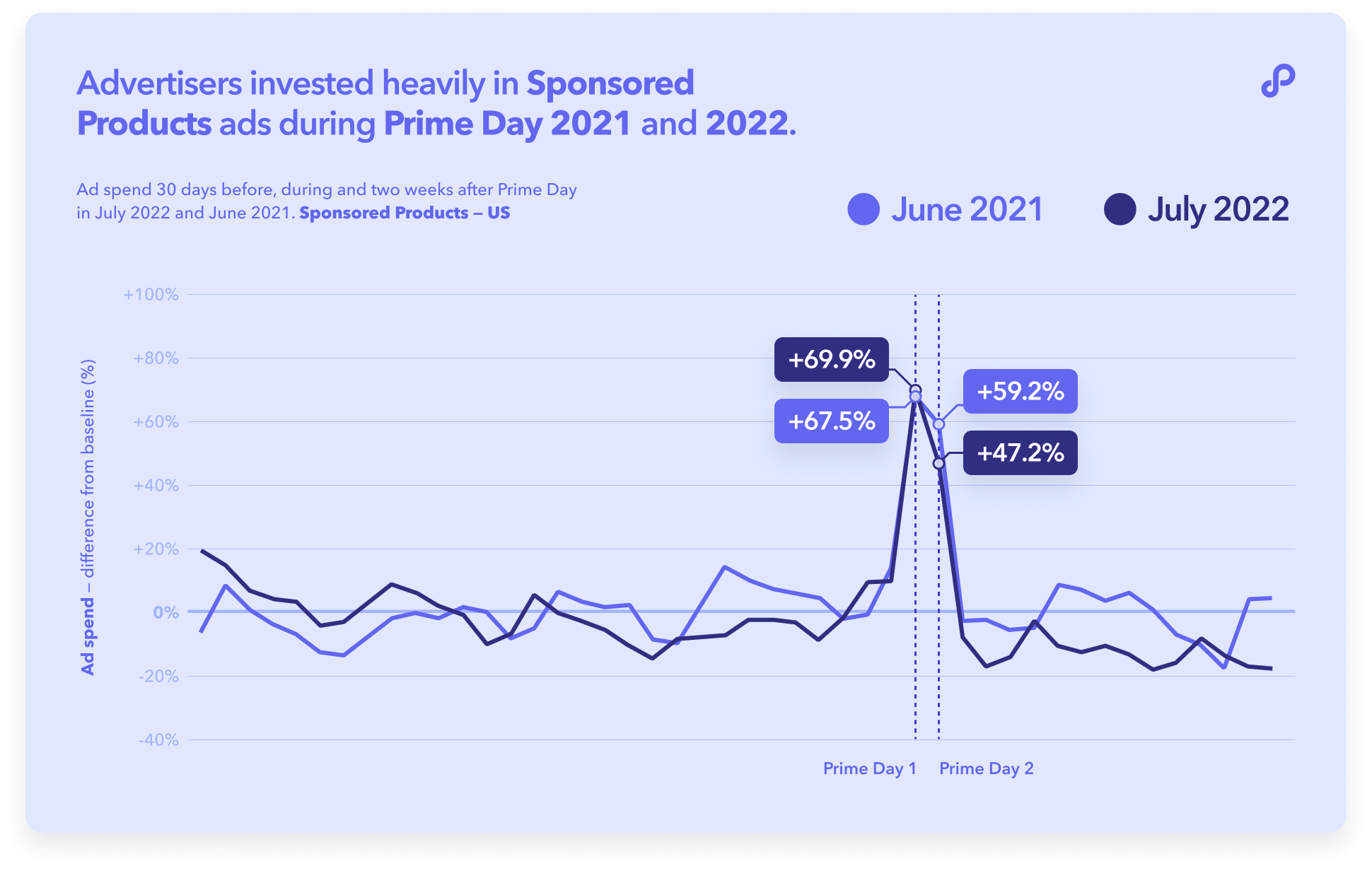
In both years, we can observe a major spike in ad spend coinciding with the increase in ad sales we saw above. Interestingly, Prime Day 2022 saw advertisers investing particularly heavily (69.9% above normal levels) on the first day of the shopping holiday, with a large drop on day two (down to 47.2% above the baseline). This shows that advertisers tend to front-load their Prime Day budgets, spending more on the first day than the second.
Can we directly connect increasing ad spend to increasing ad sales?
Using median values in an analysis of this kind is an effective way of judging the performance of a typical advertiser. However, it is possible to draw false conclusions when lumping all advertisers together, regardless of their approach to Prime Day. How do we know that those advertisers with increased spend are also the advertisers with increased sales? We don't, unless we look at the data more closely.
So let's do that.
For simplicity, we'll now focus on Prime Day 2022, as this is the most recent point of reference.
To understand the connection between strategy and results, we can split the advertisers in our dataset into three groups:
those that didn't increase spend for Prime Day
those that increased spend, but by less than 50%
those that increased spend by more than 50%.

Looking at groups 2 and 3—the ones who can be said to have applied a Prime Day strategy—we can analyze the lift in ad sales for each. To reflect a range of advertisers' experiences, we have taken each group and measured the ad sales lift at the 25th and 75th percentiles. This gives us the range of the middle 50% of advertiser performance for each group.
And the results couldn't be clearer:
Advertisers who increased ad spend by 50% or more saw sales increase by between 52% and 226%.
Advertisers who increased ad spend by less than 50% saw a sales change between a 3% decrease and a 44% increase
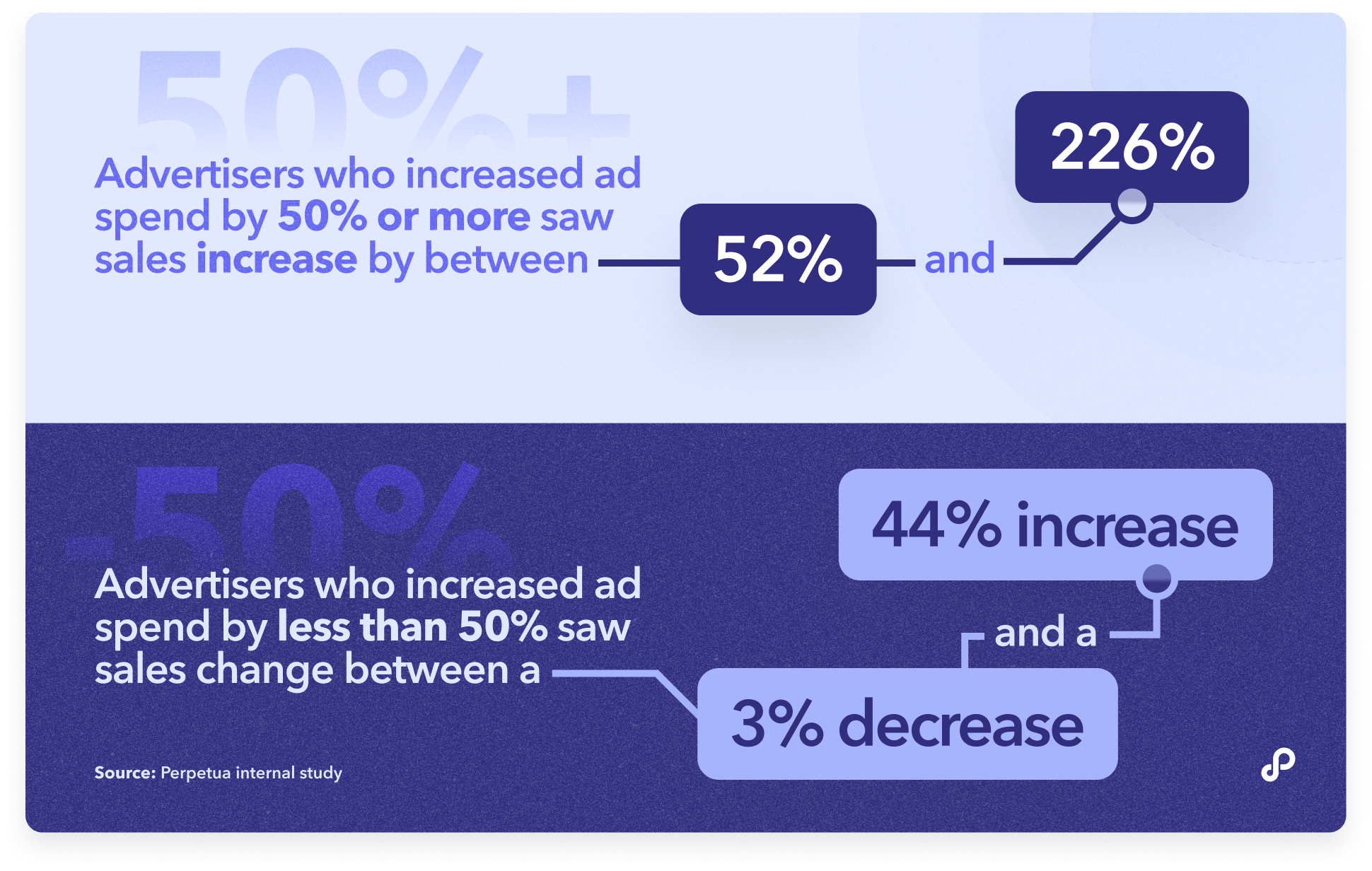
Even lower-performing advertisers (25th percentile) in the higher-spend bracket saw a bigger boost to their ad sales than higher-performing advertisers (75th percentile) in the lower-spend bracket. This demonstrates an unequivocal relationship between increased Prime Day ad spend and increased Prime Day ad sales at the level of the individual advertiser.
This result indicates that a substantial investment is usually required to produce a meaningful ad sales boost. If you aren't increasing spend, then your competitors who are will be the ones to capture a larger share of the sales—and potentially have an extremely profitable Prime Day while you miss out.
What is the impact of increasing ad budget on CPC and ACOS?
Clearly, if you are making big changes to your advertising budget, you might (rightly!) want reassurance that your CPCs and ACOS aren't going to explode. How serious is the risk of wasting budget by overspending on premium keywords that don't generate returns?
Let's take a look.
Because we want to investigate the impact of increasing your budget, we're going to focus here on advertisers with a minimum 50% increase in ad spend.
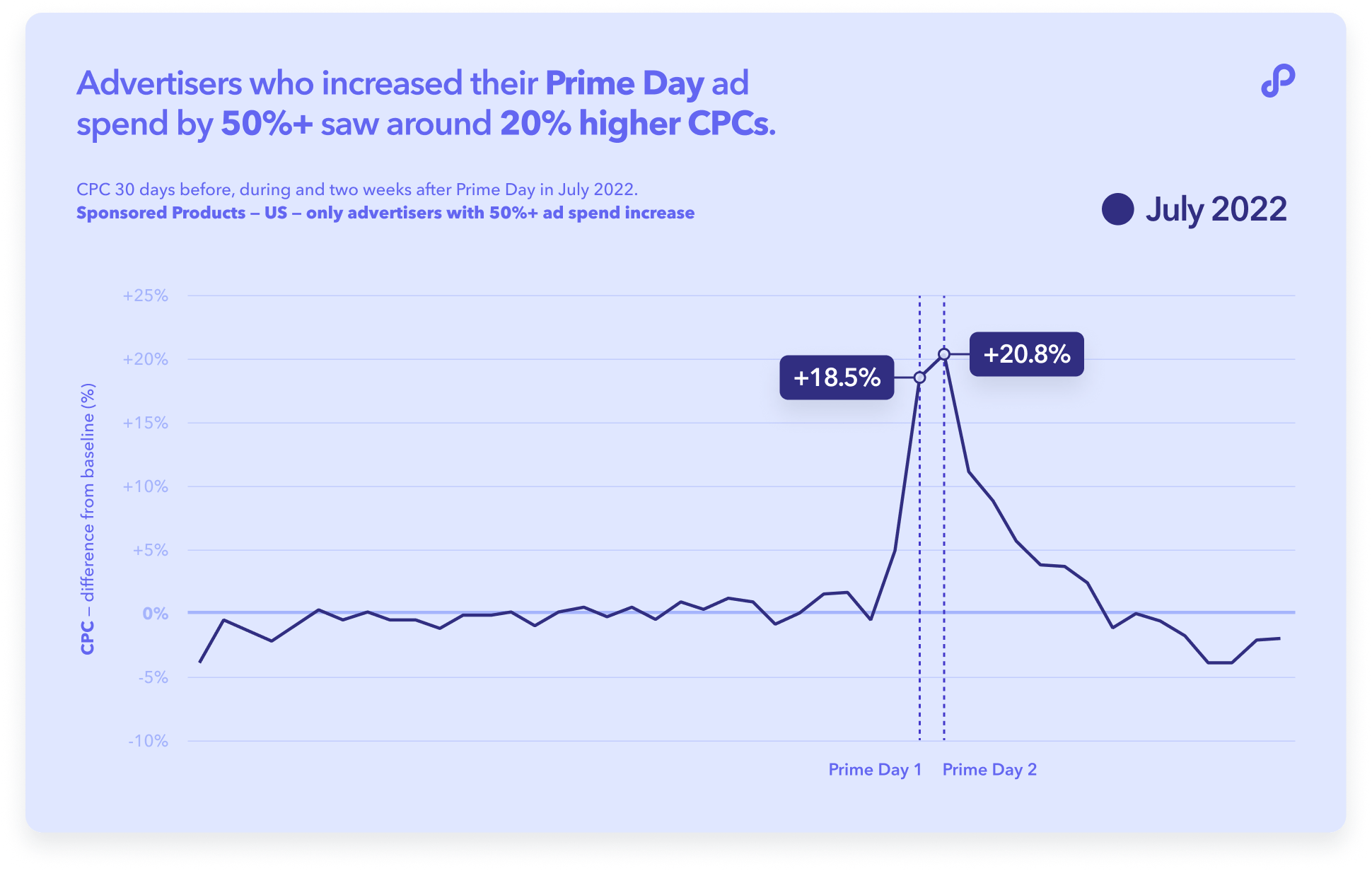
As we can see, the CPC's rise by around 20% during Prime Day. Whilst this is a significant overnight increase, it remains far below the minimum 50% additional ad spend invested by these advertisers.
This shows very simply that the additional budget is not just transferred just into higher click prices and effectively eaten up by the competition, but that it is also a result of more clicks. More clicks mean more shoppers viewing your product detail pages, and more opportunities to convert.
Now let's look at advertising cost of sale (ACOS). Again, the following chart focuses on Prime Day 2022 and represents just those accounts that raised their ad spend by 50% or more.
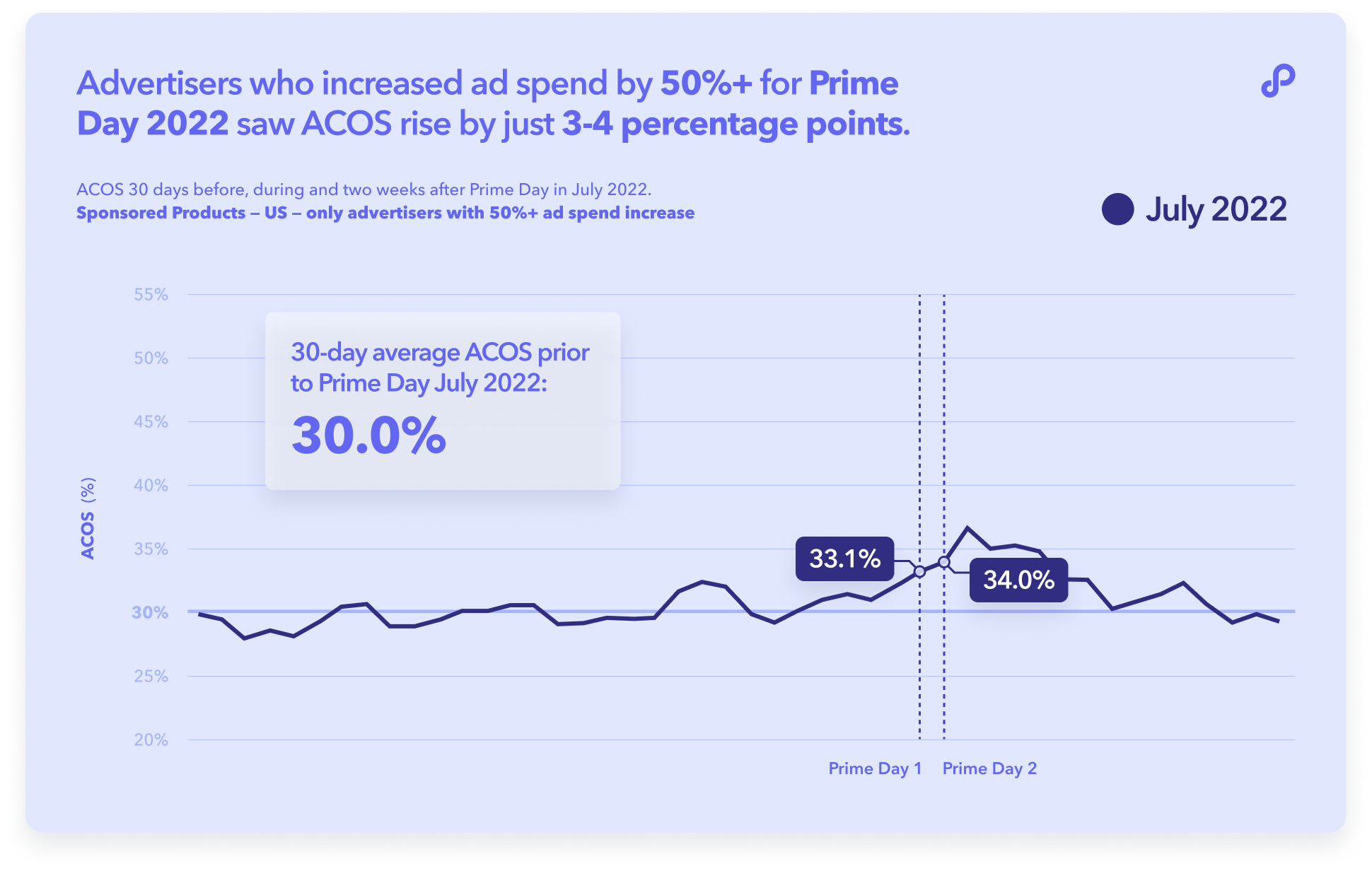
Where one might have expected ACOS to increase dramatically, in fact levels of 33.1% and 34.0% are only a few percentage points higher than the baseline of the previous 30 days. This does mean, of course, that Prime Day ads are slightly less efficient than during normal periods, but overall profits might rise considerably if sales go up by 40%-60% with only this slight uptick in the advertising cost of sale.
What do conversion rates tell us about consumer behavior on Prime Day?
As ever, it's customers—and how they behave—that dictate whether your products sell or not. So it's vitally important for your success that you understand your customers and their motivation around a major shopping event like Prime Day.
One way of gaining insight into their behavior, and one which helps explain why increasing ad spend can be so successful if done correctly, is to look at conversion rates. If conversion rates across the board are going up, then this suggests an increased readiness to buy. This could be driven by factors such as:
excitement around the opportunity to save money;
consideration has taken place in anticipation of the big day so shoppers tend to already be lower down the funnel;
perceived pressure from time-limited deals motivates quicker decision-making.
But what does the data say?
Let's look again at our cohort of advertisers who increased ad spend by more than 50% for Prime Day in July 2022.
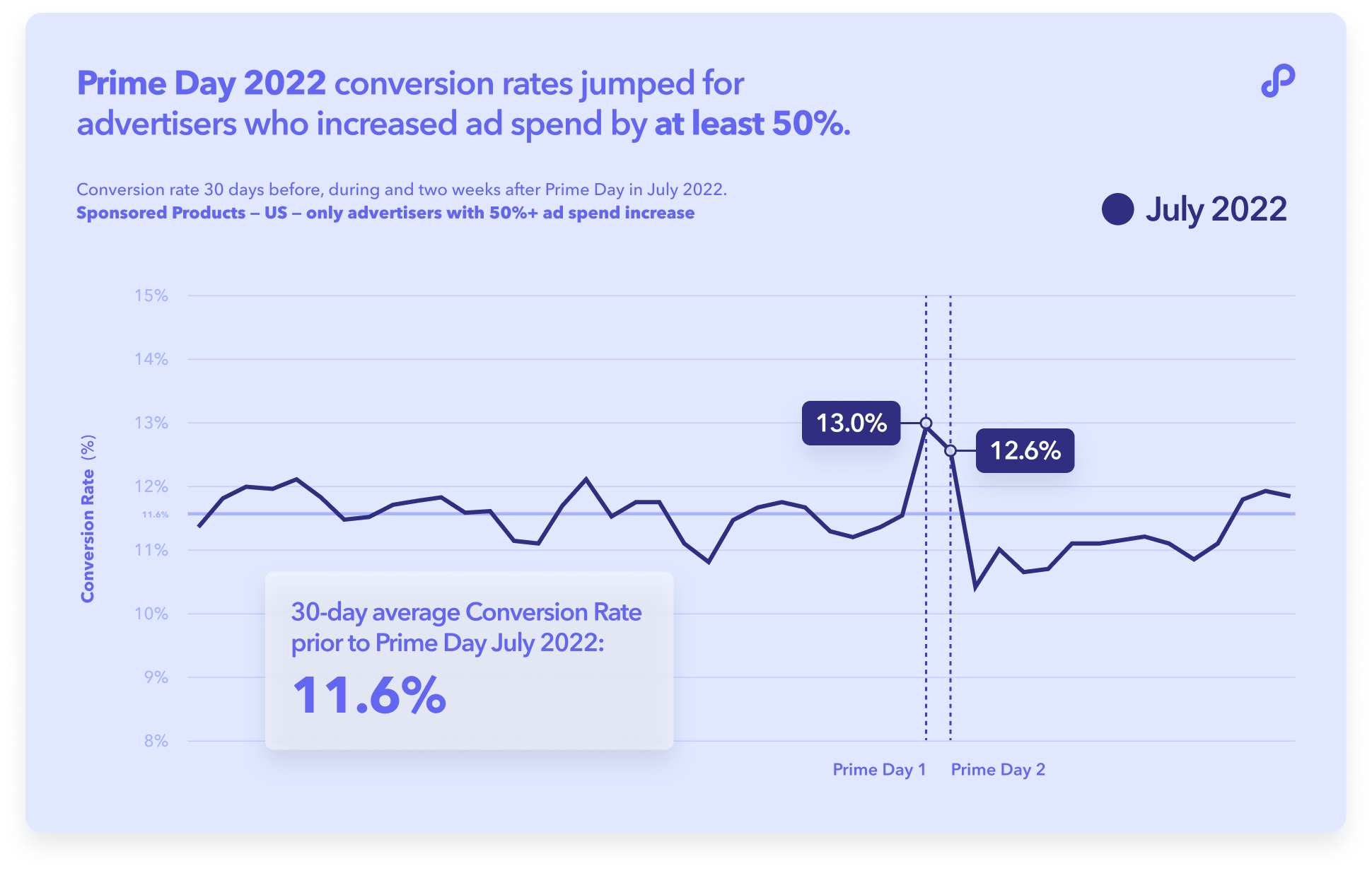
A change in conversion rate from 11.6% to 13% might not sound like too much, but this is a solid 12% increase. Coupled with the fact, as we demonstrated earlier, that these advertisers are getting more clicks, this result certainly dispels any fears that advertisers are targeting the wrong keywords, or that ad budget is being invested in an unqualified audience.
The Prime Day audience is one that is ready to convert, and raising your ad budget is your change to take advantage of this.
Key takeaways
Here's a quick summary of the findings of our Prime Day data analysis:
Since 2020, ad sales have been at least 50% above normal levels on the first day of Prime Day
The largest increase was in 2021, where Prime Day sales were 67% above the baseline;
For the last three Prime Day events, ad sales have been lower on the second day than on the first
The last fall Prime Day was in 2020, but Prime Day 2022 is likely a better indicator for this October's Prime Early Access Sale
Ad spend rises greatly on the first day of Prime Day, with an almost 70% increase in 2021 and 67.5% increase in 2022
As with ad sales, ad spend has been lower on the second day of Prime Day in recent years, though still well above baseline levels (59% higher in 2021 and 47% higher in 2022)
Advertisers who increased ad spend by 50% or more in 2022 saw sales increase by between 52% and 226%
On the other hand, advertisers who increased ad spend by less than 50% in 2022 saw a sales change between a 3% decrease and a 44% increase
Advertisers who increased ad spend by at least 50% in 2022 saw CPCs rise by about 20%
Conversion rates went up by 12% for advertisers who increased their ad spend by at least 50% for Prime Day 2022.
Our Prime Early Access Sale recommendation: Increase ad budget, but do it smartly
Looking at the data presented in this post, you could be forgiven for thinking that you can just throw money at Prime Day (or a Prime Early Access Sale) and expect guaranteed returns.
However, in order to get results that are both effective and efficient you need to be smart about this.
That’s why at Perpetua, we've developed a feature that lets you apply multi-step strategic adjustments to a set of campaigns with just a couple of clicks. This means you can react fast and be ready to maximize your wins during events such as Prime Day.
Pre-set values in our multi-step strategy adjust your bids and ACOS targets before, during and after the Prime Early Access Sale to make the most of this sales event. What does this look like? Our default recommended strategy adjusts the following values:
October 10: Increase budget by 50% to increase readiness of your campaigns beforehand and to target users who are researching. Increase your target ACOS by 15% to encourage higher bids on following days.
October 11-12: Increase budget to 100% more than normal to be prepared for the expected usual increase in ad spend and so that your campaigns don’t stop because they run out of budget. Maintain the target ACOS at 15% above normal levels to match the expected increase in CPC and make sure your ads are competitive and get enough visibility.
October 13: Set budget back to the original level and decrease ACOS to 90% of the original level during the days of “shopping fatigue” when conversion rates are expected to be lower.
October 14: Also now set ACOS to original level so that campaigns are running as normal again.
Why do I need to increase my ACOS?
In this strategy you are increasing your target ACOS, i.e. the target value that is used by the Perpetua ad automation engine. This makes sense for 2 reasons:
You might see a slight increase of ACOS during the Prime Early Access Sale, however this will be accompanied by a large increase in sales, which can increase your overall profits significantly even though ACOS is slightly higher.
The increase in target ACOS will trigger an increase in CPC that is needed to match increased competition and CPC during the event and make sure your ads get enough visibility.
You can also customize this strategy based on your experience and performance in past years. Customize your strategy or use our recommendations and easily apply them to a large number of campaigns with only a few clicks.
What are you waiting for?
You can apply our recommended strategy today and make sure you're fully prepared for the Prime Early Access Sale — the quick and easy way.
To get started or learn more about how Perpetua can help you scale your Amazon Advertising business